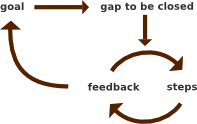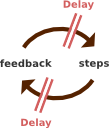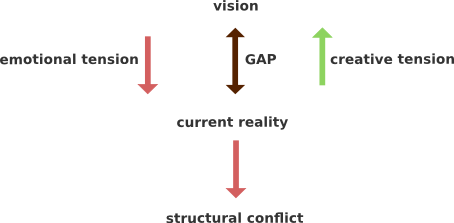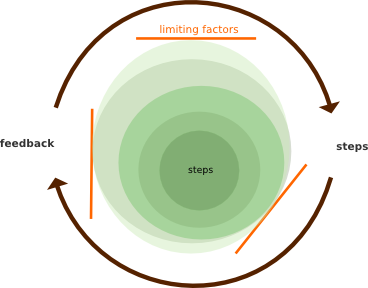You must be the change you want to see in the world
– Mahatma Gandhi
As things change fast, reacting to these changes is not a matter of some new actions but a challenge for a real shift of mind. To realize the necessity of shifting your mind again requires being aware of your underlying mental model. Which means recognizing that you have a mental model and qualifying it against a changing reality in order to detect possible misfits. A learning organization needs individual learning and both are woven into another in a multitude of complex relations.
I’m following Peter M. Senge’s The Fifth Discipline which I try to break down into some main points and sentences that might serve as a basic guideline for systems thinking and personal mastery, two concepts widely discussed in the book. As I would like to keep reading easy and do not intend a political career, I only mark quotations I literally took from the book.
Personal Mastery
If you have a vision which is far away from your current situation (which more or less is the definition of a vision) the gap makes you feel a creative tension. If you don’t see a clear path from your current situation to your vision or you feel anxious not to reach your vision, it additionally rushes you into an emotional tension. You solve this tensions by either moving toward your vision and pulling energy from the creative tension or you surrender to to the emotional tension and adapt the vision to your current reality (lower or erode the vision) and thus make it vanish.
Dealing with structural conflicts
Contrary to your vision you may have deep, often unconscious beliefs, that thwart the achievement or fulfilment of your goals. This could originate from a belief in your powerlessness – the inability to bring into being the things you care about or a feeling of unworthiness – the impression of not deserving to have what you truly want.
People tend to build coping strategies in order to cover structural conflicts:
- letting the vision erode
- manipulating the conflict (focusing on avoiding what you don’t want, defining negative visions)
- willpower (overpowering all forms of resistance to achieve your goals)
How to deal with structural conflicts? A first step is being aware of your own coping strategies and to develop an internal warning system that identifies patterns in your behavior like blaming others or saying „I’ve always got to do it all myself“. Tell the truth about your real intentions, check if your goals are in line with your vision. Try to see reality as it is, awaken from self-imposed distortion of reality, separate what you truly want from what you think you need to do in order to achieve it: „Structures of which we are unaware hold us prisoners“ (149) .
Learning organizations need learning individuals
As a company or organization you should lay the grounds for personal mastery by influencing its process without controlling it. In the best case learning is based on the building of a shared vision.
The high level of personal mastery you should target is characterized by
- a sense of purpose behind goals
- being deeply inquisitive
- being in a continual learning mode
- seeing current reality as an ally
- striving to continually seeing reality more and more accurately
- relying on your observation, not on your concept of reality
- perceiving and working with forces of change
- feeling connected to others and life itself
- feeling yourself as part of a larger creative process
- being aware of your ignorance, your incompetence and your growth area
- being able to focus on ultimate intrinsic desires
- a process of continually focusing and refocusing of what you truly want
- pursuing physical development as well as intellectual AND emotional intelligence
- a commitment to the whole
- a vision beyond self-interest
- fostering your intrinsic standard of excellence
- integration of intuition
Organizations should take care that they establish a shared vision in order to provide a focus and the energy for learning. So that people would say: “what we are doing really matters” and “our company” in stead of “their company”, the general climate should be one of cooperation not of mistrust.
Use the subconscious to amplify your potential
Focus on your visions, separate intrinsic from interim goals, scrutinize your wishes, as the subconscious seems to be receptive to unambiguous goals and goals in line with your deeper aspirations and values.
From a vision to systems thinking
If having a vision is accompanied by feeling trapped in the system, then moving from this trap needs a shift of mind. You wont succeed if you „solve the problem but not the thinking that produced the problem at first plan.“ (94). Generally speaking this means moving from a partial and isolated, narrow and individual to a global, compound and community-based view or in other words: systems thinking. Directions of your moving mindset could be:
- seeing parts -> seeing wholes
- being a helpless reactor -> becoming an active participant
- enduring reality -> shaping reality
- seeing linear cause-effect chains -> seeing complex interrelationships
- seeing a big faceless system -> seeing patterns
Restructuring a company must be accompanied by a mental change and the growth of a new culture. Installing formal frameworks – „we are agile from Monday on“, or simply moving into open space offices wont work. Solving complex issues with complex (=detailed) solutions wont work neither on the long run. Be aware of explicit and implicit goals: Don’t pray a 40 hours week but only promote people working 60 hours and more.
Be aware of delays between actions and consequences. If they turn to long neither growth nor balance will be achieved as people might be frustrated while waiting or productivity might simply stop from a lack of resources.
Amplifying, stabilizing and waiting
Kurze Unterbechung
Das ist dein Alltag?
Keine Sorge – Hilfe ist nah! Melde Dich unverbindlich bei uns und wir schauen uns gemeinsam an, ob und wie wir Dich unterstützen können.
The building block of Systems thinking is a triad of
- Reinforcing feedback
- Balancing feedback
- Delays

You should use reinforcing (amplifying) power if your target is growth, always being aware that reinforcing power could start a self-dynamic, spiral process which may turn into a good or a bad direction. Changes should be seen as a process, that starts with small steps – hopefully in the right direction. If this leads to success, produce more movement in the same direction. As soon as a limiting factor is reached your system will turn into a balancing phase. If you have attained the intended growth and stabilization is your goal now, you are fine. If not, find the limiting factors to growth and change them.
Use balancing (stabilizing) if you try to realize a goal. Your system should be running on a constant level. All components are supplied according to their needs.

All feedback processes can have a form of delay. The better you foresee delays the less impact they will have. Not seeing delays at all may have the same bad influence as overdoing actions in order to prevent a delay.
Use Pattern
Pattern help understanding the same situation in very different contexts and knowledge areas by abstraction and combination of the seemingly disparate.
Patterns could be:
- Limits to growth: If there are limits, growth may slow down so much, that the reinforcing spiral may turn in reverse. Pushing growth leads to short-time amelioration but may turn into long-term decline. Leverage: Try to identify blocking and delaying elements of the reinforcing and the balancing loops and remove them.
- shifting the burden always ends in a vicious circle. Curing the symptoms without solving the underlying fundamental problem again leads to short-term win and long-term loss (e.g. cure growing workload and stress with alcohol). A leverage could be to strengthen the fundamental response and weaken the symptomatic response.
The book offers plenty of stories that underpin the theory. Peter M. Senge is a good story teller, so besides being worthwhile reading the book is diverting too.
Sources: Peter M. Senge, The Fifth Discipline, New York 2006




Schreibe einen Kommentar